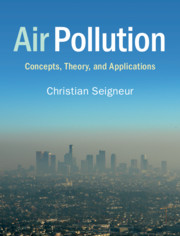Book contents
- Air Pollution
- Air Pollution
- Copyright page
- Contents
- Preface
- Main Notations
- 1 Brief History of Air Pollution
- 2 Emissions of Air Pollutants and Emission Control Technologies
- 3 Meteorology: General Circulation
- 4 Air Pollution Meteorology
- 5 Atmospheric Radiative Transfer and Visibility
- 6 Atmospheric Dispersion
- 7 The Stratospheric Ozone Layer
- 8 Gaseous Pollutants
- 9 Atmospheric Particles
- 10 Clouds and Acid Rain
- 11 Transfer of Pollutants between the Atmosphere and Surfaces
- 12 Health Effects
- 13 Environmental Impacts
- 14 Climate Change and Air Pollution
- 15 Regulations and Public Policies
- Index
- References
11 - Transfer of Pollutants between the Atmosphere and Surfaces
Published online by Cambridge University Press: 19 June 2019
- Air Pollution
- Air Pollution
- Copyright page
- Contents
- Preface
- Main Notations
- 1 Brief History of Air Pollution
- 2 Emissions of Air Pollutants and Emission Control Technologies
- 3 Meteorology: General Circulation
- 4 Air Pollution Meteorology
- 5 Atmospheric Radiative Transfer and Visibility
- 6 Atmospheric Dispersion
- 7 The Stratospheric Ozone Layer
- 8 Gaseous Pollutants
- 9 Atmospheric Particles
- 10 Clouds and Acid Rain
- 11 Transfer of Pollutants between the Atmosphere and Surfaces
- 12 Health Effects
- 13 Environmental Impacts
- 14 Climate Change and Air Pollution
- 15 Regulations and Public Policies
- Index
- References
Summary
The atmosphere interacts with the Earth’s surface. Thus, air pollutants may be transferred toward surfaces and emitted (or reemitted) from surfaces toward the atmosphere. Atmospheric deposition processes are important because (1) they impact the atmospheric lifetime of air pollutants and (2) they may lead to the contamination of other environmental media. Processes of emission and reemission may contribute significantly to the atmospheric budget of some pollutants and it is, therefore, essential to take those into account. This chapter describes the mechanisms that lead to atmospheric deposition of pollutants, either via dry processes (dry deposition) or via precipitation scavenging (wet deposition). Emissions of particles by the wind (aeolian emissions), waves, and on-road traffic are also described.
- Type
- Chapter
- Information
- Air PollutionConcepts, Theory, and Applications, pp. 259 - 285Publisher: Cambridge University PressPrint publication year: 2019



